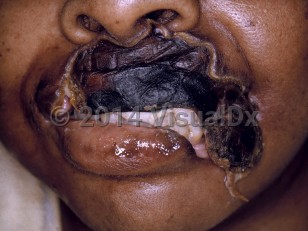Noma
Alerts and Notices
Important News & Links
Synopsis

Noma, also known as cancrum oris, is a polybacterial destructive infection of the mouth that typically occurs in impoverished children living in developing countries with limited access to health care, proper nutrition, and clean living situations.
Noma is thought to arise when primary necrotizing gingivitis (acute necrotizing ulcerative gingivitis [ANUG]) progresses to necrosis of oral mucosal tissue and surrounding fascia, muscle, and bone. Risk factors include poor oral hygiene and overgrowth of anaerobic bacteria in gingival plaque, in concert with malnutrition and a preceding or intercurrent infection (such as tuberculosis, scarlet fever, or measles), immunodeficiency (such as HIV), or malignancy. While most affected individuals are children aged younger than 7 years, adults with noma have also been reported. Some of the common bacteria identified in the pathogenesis of this disease include Prevotella intermedia, Peptostreptococcus species, and Fusobacterium necrophorum.
In the early stage of noma, there is often perioral edema, halitosis, and necrosis of the oral mucosa beyond the gums. The disease quickly progresses, destroying muscle and bone, and can leave a full-thickness orofacial defect within days. Fever, dehydration, and pain accompany the condition. In the absence of treatment, the mortality rate is as high as 90%, usually due to sepsis; this rate drops to 10% with proper antibiotic and supportive treatment. In those who survive, sequelae include permanent facial defects that may interfere with eating and speech, scarring, and trismus.
Noma has also been rarely reported on the perineum, scrotum, and vulva (noma pudendi). Noma neonatorum is the presence of necrotizing lesions of the mouth and anus in neonates who are premature or small for gestational age with intercurrent malnutrition and sepsis (usually due to Pseudomonas aeruginosa).
Noma is thought to arise when primary necrotizing gingivitis (acute necrotizing ulcerative gingivitis [ANUG]) progresses to necrosis of oral mucosal tissue and surrounding fascia, muscle, and bone. Risk factors include poor oral hygiene and overgrowth of anaerobic bacteria in gingival plaque, in concert with malnutrition and a preceding or intercurrent infection (such as tuberculosis, scarlet fever, or measles), immunodeficiency (such as HIV), or malignancy. While most affected individuals are children aged younger than 7 years, adults with noma have also been reported. Some of the common bacteria identified in the pathogenesis of this disease include Prevotella intermedia, Peptostreptococcus species, and Fusobacterium necrophorum.
In the early stage of noma, there is often perioral edema, halitosis, and necrosis of the oral mucosa beyond the gums. The disease quickly progresses, destroying muscle and bone, and can leave a full-thickness orofacial defect within days. Fever, dehydration, and pain accompany the condition. In the absence of treatment, the mortality rate is as high as 90%, usually due to sepsis; this rate drops to 10% with proper antibiotic and supportive treatment. In those who survive, sequelae include permanent facial defects that may interfere with eating and speech, scarring, and trismus.
Noma has also been rarely reported on the perineum, scrotum, and vulva (noma pudendi). Noma neonatorum is the presence of necrotizing lesions of the mouth and anus in neonates who are premature or small for gestational age with intercurrent malnutrition and sepsis (usually due to Pseudomonas aeruginosa).
Codes
ICD10CM:
A69.0 – Necrotizing ulcerative stomatitis
SNOMEDCT:
18116006 – Cancrum oris
A69.0 – Necrotizing ulcerative stomatitis
SNOMEDCT:
18116006 – Cancrum oris
Look For
Subscription Required
Diagnostic Pearls
Subscription Required
Differential Diagnosis & Pitfalls

To perform a comparison, select diagnoses from the classic differential
Subscription Required
Best Tests
Subscription Required
Management Pearls
Subscription Required
Therapy
Subscription Required
References
Subscription Required
Last Reviewed:05/05/2021
Last Updated:05/09/2021
Last Updated:05/09/2021

